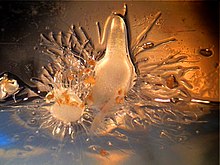蘭菌根:修订间差异
(没有差异)
|
2018年8月15日 (三) 01:20的版本
蘭菌根(英語:Orchid mycorrhiza)是蘭科植物與真菌所形成的一種菌根。蘭菌根對許多蘭科植物種子的萌發相當重要,因為許多蘭科的種子不具有任何能養分儲備,完全以菌異營的方式從寄生的真菌獲取其需要的有機養分。蘭菌根中,真菌在蘭花的根部形成稱為菌絲團(pelotons)的構造[1]。
種子萌發

蘭花的發育經過種子、原球體(protocorm)與成熟植株等三個階段。蘭花的種子非常小,長僅約0.35-1.5毫米,呈紡錘狀,其尖端有一個開口[2],尚無胚芽、胚根等分生組織[3],且不具備能供給自身生長的養分[4],而需從共生的真菌處獲取[1]。種子萌發時,形成稱為由薄壁組織組成的原球體[5][3],並在幾天之內形成分生組織[6]。
有些蘭花缺乏葉綠素,是絕對菌異營者,生活史的所有階段均依賴真菌提供有機養分[7]。有些蘭花是附生植物,其葉可能具有葉綠素,但種子萌發時仍可能需要真菌的協助以加快萌發速度並促進原球體的生長[8]。已有許多研究探討形成蘭菌根的真菌種類,土壤中這些真菌的存在與否可能是蘭科植物種子是否能順利萌發的重要因素,且可能比原先認為的其他因素,如與親本植株的距離與地理位置等更加重要[9]。
真菌進入蘭花
真菌可於蘭花種子的不同階段進入其體內,菌絲可以穿透蘭科植物的種子、原球體或成株的根部[10],進入蘭花的菌絲通常含有許多粒線體[11]。許多成株蘭花有一些較粗、分岔較少的根,即為有利菌絲進入的構造[12],菌絲通常從根毛的尖端進入植物,進入後使根毛形狀扭曲[4]。通常真菌進入蘭花後,它們的共生關係會一直持續[13],不過有研究表明在乾旱等極端環境下蘭花可以替換與其共生的真菌[14]。
真菌進入蘭花的細胞後,其菌絲會形成稱為菌絲團(pelotons)的捲狀構造[1],菌絲團是蘭菌根不同於其他種菌根的特有構造[15],其與蘭花的細胞質不直接接觸,而是以蘭花的細胞壁或其他表面介質分隔[16]。不同菌絲團的大小與包裹緊密程度均可能有差異[6]。菌絲團最後會被分解,形成蘭花細胞中黃色至棕色的塊狀構造[5],菌絲團分解的過程亦是當前的研究熱點,有研究發現菌絲團被宿主微管包圍的部位恰是首先崩解之處[16]。菌絲團分解後,新的菌絲會繼續進入蘭花細胞,生成新的菌絲團[12]。剛被菌絲入侵的蘭花細胞通常有大顆的澱粉粒,而已有崩解的菌絲團的細胞則闕如,因此澱粉的分解可能與真菌在蘭花根部的拓殖有關[11]。蘭花根部被真菌感染的皮質細胞以及鄰近細胞內的DNA含量均會增加,造成細胞核體積變大[17],DNA的增加可能與薄壁細胞的分化有關[18]。
研究歷史
蘭科植物與真菌的共生關係最早於1899年由法國植物學家諾爾·貝爾納提出,蘭花的生長是否一定需要依賴蘭菌根是長久以來研究人員爭論之處,1922年美國植物學家路易斯·克努森發現蘭花種子可在加入真菌萃取物的培養基上,缺乏蘭菌根的情況下萌發。不過近期有研究主張蘭菌根能使蘭花種子(特別是萌發於土壤中的非附生真菌)萌發的成功率顯著上升[8]。
參考資料
- ^ 1.0 1.1 1.2 Smith, S. E.; Read, D. J.; Harley, J. L. Mycorrhizal symbiosis 2nd. San Diego, Calif.: Academic Press. 1997. ISBN 0126528403. OCLC 35637899.
- ^ Arditti, Joseph; Michaud, Justine D.; Healey, Patrick L. Morphometry of Orchid Seeds. I. Paphiopedilum and Native California and Related Species of Cypripedium. American Journal of Botany. 1979, 66 (10): 1128–1137. JSTOR 2442211. doi:10.2307/2442211.
- ^ 3.0 3.1 Peterson, R. Larry; Massicotte, Hugues B.; Melville, Lewis H. Mycorrhizas : anatomy and cell biology. Ottawa: NRC Research Press. 2004. ISBN 0851999018. OCLC 57587171.
- ^ 4.0 4.1 Sathiyadash, Kullaiyan; Muthukumar, Thangavelu; Uma, Eswaranpillai; Pandey, Radha Raman. Mycorrhizal association and morphology in orchids. Journal of Plant Interactions. 2012-09-01, 7 (3): 238–247. ISSN 1742-9145. doi:10.1080/17429145.2012.699105.
- ^ 5.0 5.1 Selosse, Marc-André; Minasiewicz, Julita; Boullard, Bernard. An annotated translation of Noël Bernard’s 1899 article ‘On the germination of Neottia nidus-avis’. Mycorrhiza. 2017-08-01, 27 (6): 611–618. ISSN 0940-6360. doi:10.1007/s00572-017-0774-z (英语).
- ^ 6.0 6.1 Hadley, G.; Williamson, B. Analysis of the Post-Infection Growth Stimulus in Orchid Mycorrhiza. New Phytologist. 1971-05-01, 70 (3): 445–455. ISSN 1469-8137. doi:10.1111/j.1469-8137.1971.tb02546.x (英语).
- ^ McKendrick, S. L.; Leake, J. R.; Taylor, D. Lee; Read, D. J. Symbiotic germination and development of the myco-heterotrophic orchid Neottia nidus-avis in nature and its requirement for locally distributed Sebacina spp.. New Phytologist. 2002-04-01, 154 (1): 233–247. ISSN 1469-8137. doi:10.1046/j.1469-8137.2002.00372.x (英语).
- ^ 8.0 8.1 Alghamdi, Sameera A. Influence of mycorrhizal fungi on seed germination and growth in terrestrial and epiphytic orchids. Saudi Journal of Biological Sciences. doi:10.1016/j.sjbs.2017.10.021.
- ^ McCormick, M. K., Taylor, D. L., Whigham, D. F. and Burnett, R. K. Germination patterns in three terrestrial orchids relate to abundance of mycorrhizal fungi. J Ecol 104: 744–754. 2016. doi:10.1111/1365-2745.12556.
- ^ Martin, Francis. Molecular mycorrhizal symbiosis. Hoboken, New Jersey. ISBN 9781118951415. OCLC 958205579.
- ^ 11.0 11.1 Peterson, R. L.; Currah, R. S. Synthesis of mycorrhizae between protocorms of Goodyera repens (Orchidaceae) and Ceratobasidium cereale. Canadian Journal of Botany. 1990-05-01, 68 (5): 1117–1125. ISSN 0008-4026. doi:10.1139/b90-141.
- ^ 12.0 12.1 Rasmussen, Hanne N.; Whigham, Dennis F. Phenology of roots and mycorrhiza in orchid species differing in phototrophic strategy. New Phytologist. 2002-06-01, 154 (3): 797–807. ISSN 1469-8137. doi:10.1046/j.1469-8137.2002.00422.x (英语).
- ^ Pecoraro, L.; Girlanda, M.; Kull, T.; Perini, C.; Perotto, S. Molecular identification of root fungal associates in Orchis pauciflora Tenore. Plant Biosystems - An International Journal Dealing with all Aspects of Plant Biology. 2012-12-01, 146 (4): 985–991. ISSN 1126-3504. doi:10.1080/11263504.2011.634447.
- ^ McCormick, Melissa K.; Whigham, Dennis F.; Sloan, Dan; O'Malley, Kelly; Hodkinson, Brendan. [903:OFAMMT2.0.CO;2/abstract Orchid–Fungus Fidelity: A Marriage Meant to Last?]. Ecology. 2006-04-01, 87 (4): 903–911. ISSN 1939-9170. doi:10.1890/0012-9658(2006)87[903:ofammt]2.0.co;2 (英语).
- ^ Rasmussen, Hanne N. Recent developments in the study of orchid mycorrhiza. Plant and Soil. 2002, 244 (1/2): 149–163. JSTOR 24130393. doi:10.2307/24130393.
- ^ 16.0 16.1 Uetake, Yukari; Farquhar, Melissa L.; Peterson, R. Larry. Changes in microtubule arrays in symbiotic orchid protocorms during fungal colonization and senescence. New Phytologist. 1997-04-01, 135 (4): 701–709. ISSN 1469-8137. doi:10.1046/j.1469-8137.1997.00686.x (英语).
- ^ Hadley, G.; Williamson, B. Features of Mycorrhizal Infection in Some Malayan Orchids. New Phytologist. 1972-11-01, 71 (6): 1111–1118. ISSN 1469-8137. doi:10.1111/j.1469-8137.1972.tb01989.x (英语).
- ^ Alvarez, Marvin R. Quantitative Changes in Nuclear DNA Accompanying Postgermination Embryonic Development in Vanda (Orchidaceae). American Journal of Botany. 1968, 55 (9): 1036–1041. JSTOR 2440469. doi:10.2307/2440469.
